![How to Calculate Employee Turnover [with Proven Strategies to Reduce It] How to Calculate Employee Turnover [with Proven Strategies to Reduce It]](/sites/default/files/image_1621.png)
Businesses today are facing a wave of employee resignations at a higher rate than ever. People analytics firm Visier reveals that at least one in four people quit their jobs in 2021.
It’s not surprising that monitoring employee retention and turnover has been a major focus of business leaders and human resources. When a team member leaves, there are many factors that impact the company’s decision-making that revolves around recruitment, training, and compensation package, among others.
The first few things you will notice after losing an employee are decrease in morale and low productivity in the workplace. And if you want to retain high-performing team members, you’ve come to the right place.
In this article, we’ll discuss the true value of employee turnover, different ways to calculate it, and strategies your business can use to improve retention. Let’s get started.
Quick Reads
- What Is Employee Turnover?
- Why Is Employee Turnover Important to Your Organization?
- Difference Between Voluntary and Involuntary Turnover
- What Is a Healthy Turnover Rate?
- The Best Formula When Calculating Turnover Rate
- Analyze Turnover Rate
- Effective Strategies to Reduce Turnover
- The Cost of Replacing Employees
- How to Calculate Monthly Employee Turnover
- How to Calculate Annual Employee Turnover
- How to Calculate Overall Employee Turnover
- How to Calculate New Employee Turnover
- Alternative Formula to Calculate Turnover
- Download Employee Turnover Ratio Calculator Template
What Is Employee Turnover?
Employee turnover rate is the measurement or percentage of employees who leave a company or an organization during a certain period of time. It also indicates the duration employees choose to stay and work.
While it typically deals with the total number of employees who resign, you can also apply turnover to demographic groups or individual departments. Employers need to measure employer turnover to assess the reasons or causes of resignation and set the budget for getting new hires.
Why Is Employee Turnover Important to Your Organization?
Checking and evaluating employee turnover is a vital function of the HR department to measure human resources and organizational management.
Suppose your organization’s turnover rate is high. In that case, you must plan for additional costs of hiring new employees as the recruitment process includes interviews, calling references, and providing product training.
In addition, a high employee turnover rate can be challenging and expensive. According to The Society for Human Resource Management (SHRM) research, replacing an employee can cost as high as 50%-60% of an employee’s annual salary, with total costs linked with turnover ranging from 90% to 200% of the annual salary.
Difference Between Voluntary and Involuntary Turnover
The two main reasons employees leave a company can be voluntary or involuntary. Voluntary turnover is when employees willingly leave the organization, usually because they accepted a job offer from another company. If you opt not to fill their roles, that will be part of the organization's attrition.
On the contrary, involuntary turnover happens when employees don't decide to leave a company. In other words, it's linked to employment termination due to lack of job knowledge, excessive absence from work, or violation of company policies.
What Is a Healthy Turnover Rate?
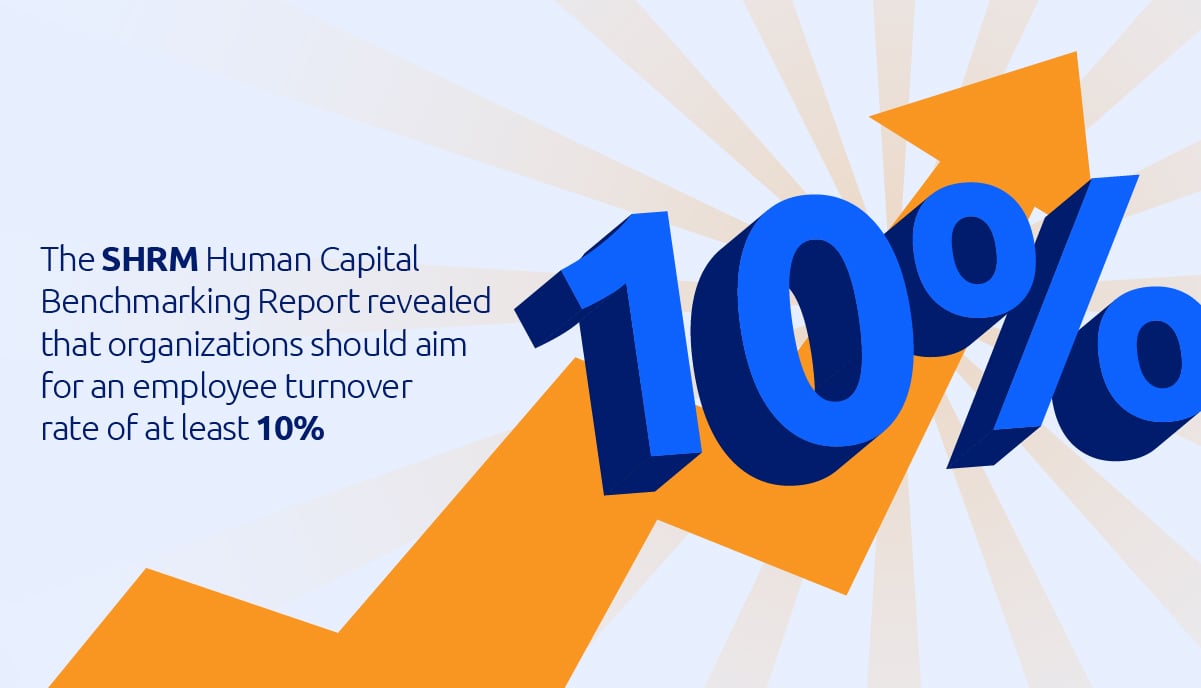
The SHRM Human Capital Benchmarking Report revealed that for companies to have a good turnover rate, it should be at least 10%, with 90% as the average employee retention rate.
However, most organizations fall into the range of 12% to 20%. Having said that, hiring high-performing team members to replace the 10% low performers is advised.
Factors like the nature of the job can lead to a high turnover rate depending on the industry. According to LinkedIn's research, technology, retail & consumer products, media & entertainment, professional services, and government have the highest employee turnover rates.
On the other hand, another good way to describe employee retention rate is to keep employee satisfaction high. Employee Net Promoter Score (eNPS) is an excellent way to measure it, especially when optimizing internal operations. It's a method for gauging employees' willingness to recommend the workplace to others.
The Best Formula When Calculating Turnover Rate
You can use different ways or numbers in employee turnover calculation depending on what you need to measure.
When it comes to competitive retention rates, separation should be considered as voluntary resignations. This is because non-voluntary separations and retirements don't equate to losing employees for the reason that other companies hired them.
However, if you need to measure overall turnover in the company, it's essential to include all separations. Keep in mind that you have to disclose to others that you include retirements in the turnover calculation.
Another great way to compute turnover and get valuable insights is to check and compare whether the new hire turnover rate is higher or lower than the company's overall turnover rate.
Analyze Turnover Rate
Who
Once you know your company’s turnover rate, the next step is to compare it to the industry average. Whether it’s lower or higher, make sure to identify the individuals who leave the organization.
If top performers are leaving the company, make sure to take immediate action. Assess the growth opportunities, compensation package, purpose, and recognition you offer to understand how to retain your staff in the future.
On the other hand, if low performers are resigning or leaving, you can experience better employee productivity, engagement, and profits.
When
Keeping track of the time people leave can be beneficial to the insights you seek. For example, the new hire turnover rate is the number of employees in a company that leaves the job within a year or a particular duration period. It's an important determinant of whether recruitment methods in hiring and onboarding employees are working.
If a significant number of new employees leave because their work responsibilities become more complicated than expected, it's time to review your job descriptions.
On the other hand, if an employee's reason for leaving is poor organizational fit, investing time and money in developing a work orientation process is crucial. You can offer other employee engagement initiatives like company values, personal coaching, employee-led teaching programs, and online communication channels to respond to their feedback and get their attention.
Why
It is essential to know the reasons why employees leave. This can help you reevaluate your company’s management style or set new policies in response.
If employees observe that their co-workers are leaving, it can affect the overall morale of the workplace, prompting them to question their opportunities for growth in the company. For this reason, some may consider looking for better opportunities elsewhere.
Exit interviews are valuable to assess the overall employee experience and identify the necessary steps to increase retention and boost engagement.
For example, employees often say they decided to resign because they felt unappreciated and believed they could look for other positions outside the company that could pay them more.
If you get these answers on questionnaires during exit interviews or performance reviews, the human resource department should work with managers to improve the performance evaluation process.
Employee turnover rate is a critical issue most businesses face. It would be best not to ignore a high turnover rate as it can negatively affect an organization.
Therefore, it’s essential to review your recruitment process as well as recruitment marketing strategies. Hiring the right people, closely monitoring unproductive employees, prioritizing work-life balance, and rewarding employees are also some of the top employee retention tasks you should consider.
Ultimately, you can improve company performance and keep top talent if you reduce turnover through robust retention strategies.
To avoid high turnover, it’s crucial to calculate the turnover rate at your company. After this, you can take action and make some necessary adjustments to decrease it.
Effective Strategies to Reduce Turnover
When Indeed performed a survey to 1,000 job seekers 44% said they left a job within the first six months. If you want to reduce employee turnover, begin by assessing the hiring process.
The recruitment phase can help set realistic expectations when writing job descriptions, conducting effective job interviews, and supporting employee growth and professional development after onboarding.
Once you've identified the reasons behind the turnover, you can implement the following strategies below to increase employee retention.
Create Learning and Development Programs. Learning and development initiatives can improve satisfaction and morale among employees. You can establish clear learning and development protocols and allow employees to pursue areas that interest them.
Build an Effective Onboarding Process. Employees find it meaningful to work in organizations whose core values align with their own. Educating new team members on the company's core values is a must to understand what matters most to you and what makes the organization unique.
Communicate Clearly. Communication is key in understanding goals and values across all departments. Doing this can help employees understand how they can contribute to overall organizational success.

The Cost of Replacing Employees
Replacing employees is costly in many ways. The estimated amount of replacing an individual employee can range from one-half to two times the employee's annual salary.
First, you need to create a strategic plan to find new employees and decide if you'll consider internal candidates. Next, you might consider doing job interviews off-site to maintain privacy and confidentiality in the workplace.
In addition, it may also be necessary to put extra cash into getting a recruitment agency to speed up the hiring process. Your recruiter can take the lead and offer a vast pool of vetted candidates you require to find a replacement fast.
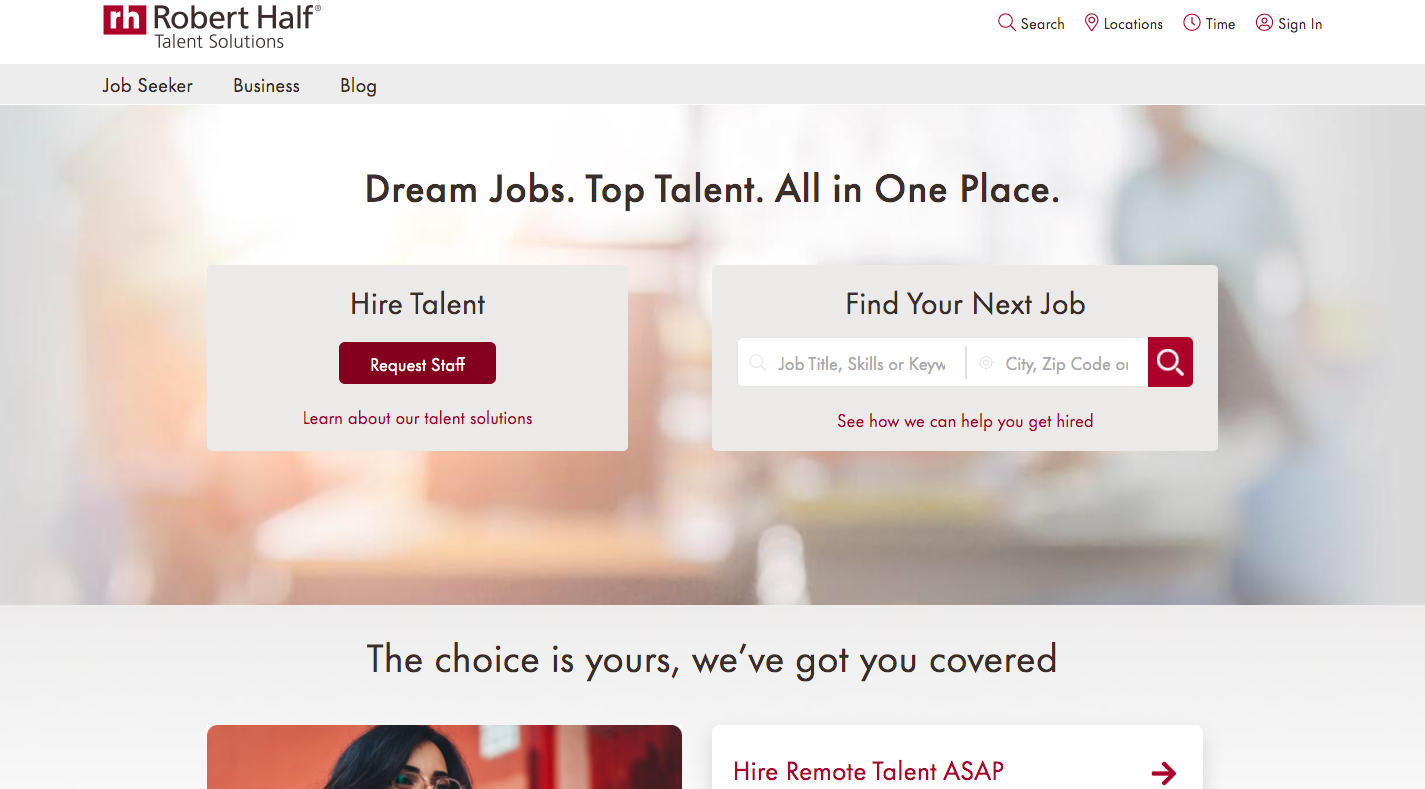
Whether you need someone or an entire team to work on a project, Robert Half Talent Solutions can match you to skilled permanent or contractual candidates for various industries. Its recruiting specialists can quickly find the right talents who fit your company best.
How to Calculate Monthly Employee Turnover
There are three numbers that you need to calculate the monthly turnover rate: the numbers of active employees at the beginning (B), end (E) of the month, and the number of employees who left (L) during the same month.
To get the average (Avg) number of employees, add the beginning and ending workforce. Once you get the sum, divide it by two (Avg = [B+E]/2).
Next, divide the number of employees who left by the average number of employees. You can now get the final turnover percentage by multiplying it by 100 ([L/Avg] x 100).
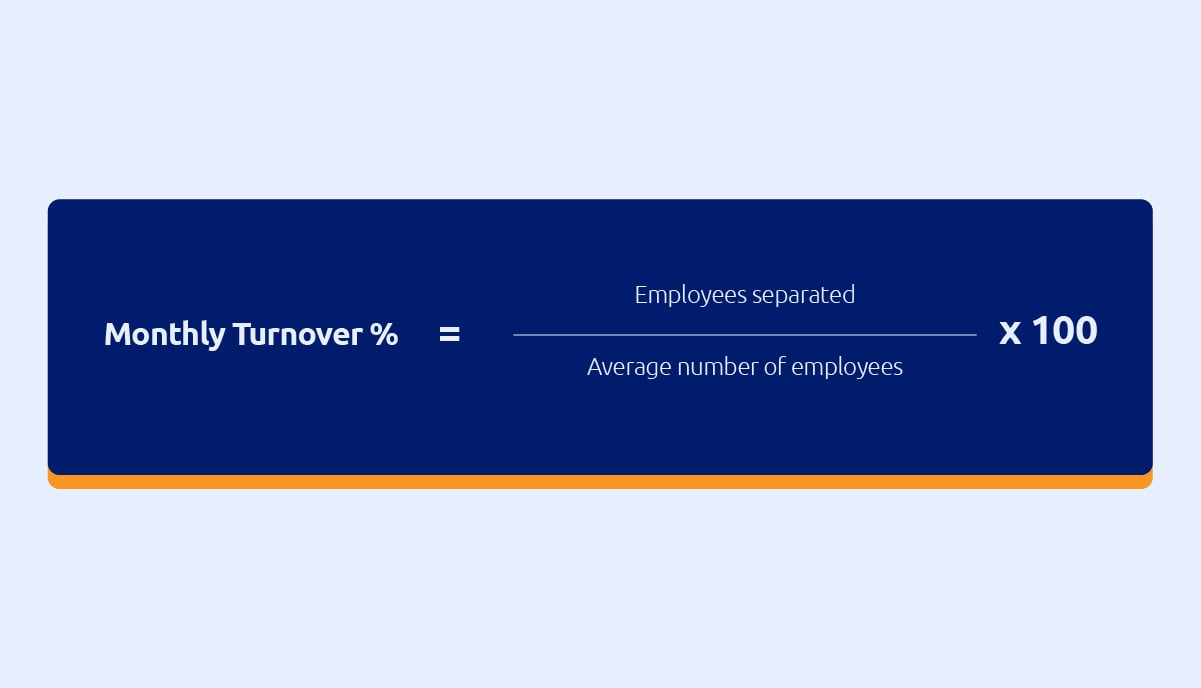
How to Calculate Annual Employee Turnover
You may opt to calculate the quarterly or annual turnover rate because it may require significant figures to obtain valuable insights.
The annual employee turnover rate calculation formula is:
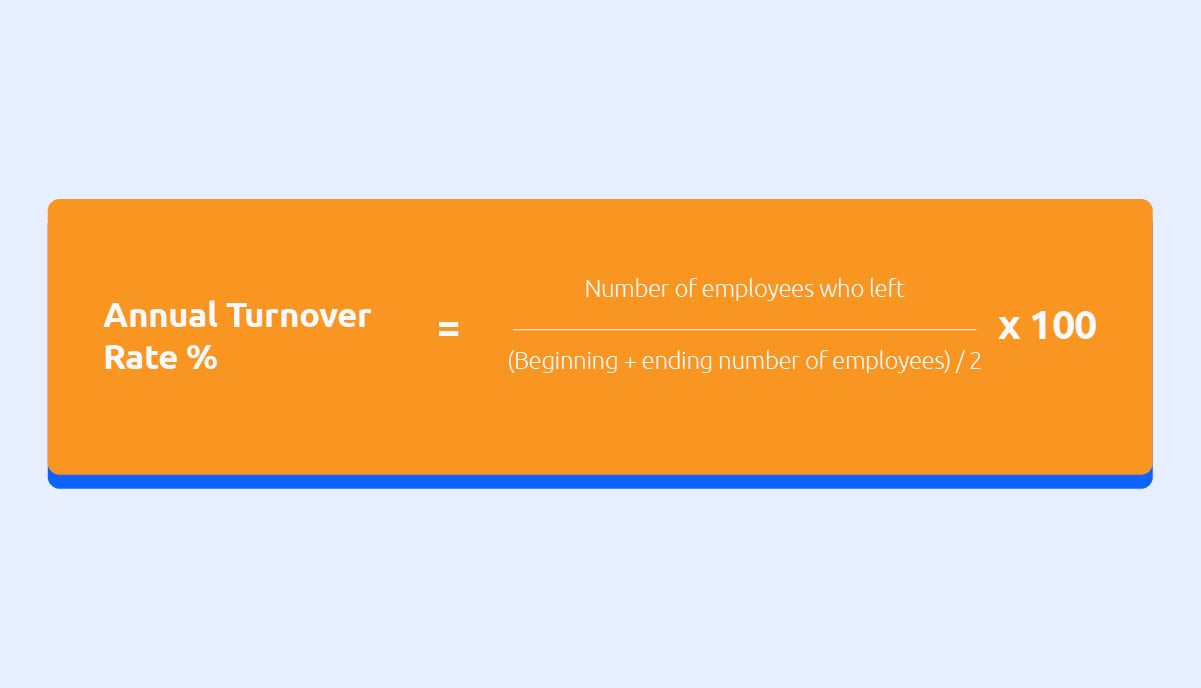
How to Calculate Overall Employee Turnover
To get the overall employee turnover, get the average number of employees during the measurement period.
Get the number of employees at the beginning of the period. Next, add it to the number at the end of the period.
Divide the sum by two to find the average number of employees. After getting the results, divide the number of employees separated during the period by the average number of employees. It will now show you the employee turnover rate.
The formula is R = S/((B + E)/2). R is the turnover rate, while S is the number of separated employees. B and E represent the beginning and ending size of your workforce.
For example, there are 100 employees at the start of the period and 120 at the end. This gives you 110 as the average number of employees. If 10 employees left the company, that’s 10/110, or 0.09. You can multiply it by100 to get the figure 9%.
How to Calculate New Employee Turnover
We advise you to check whether the new hire turnover rate is higher or lower than the overall turnover rate. The definition of the new hire turnover rate is the number of new employees who leave within a year.
The new hire employee turnover rate formula is:
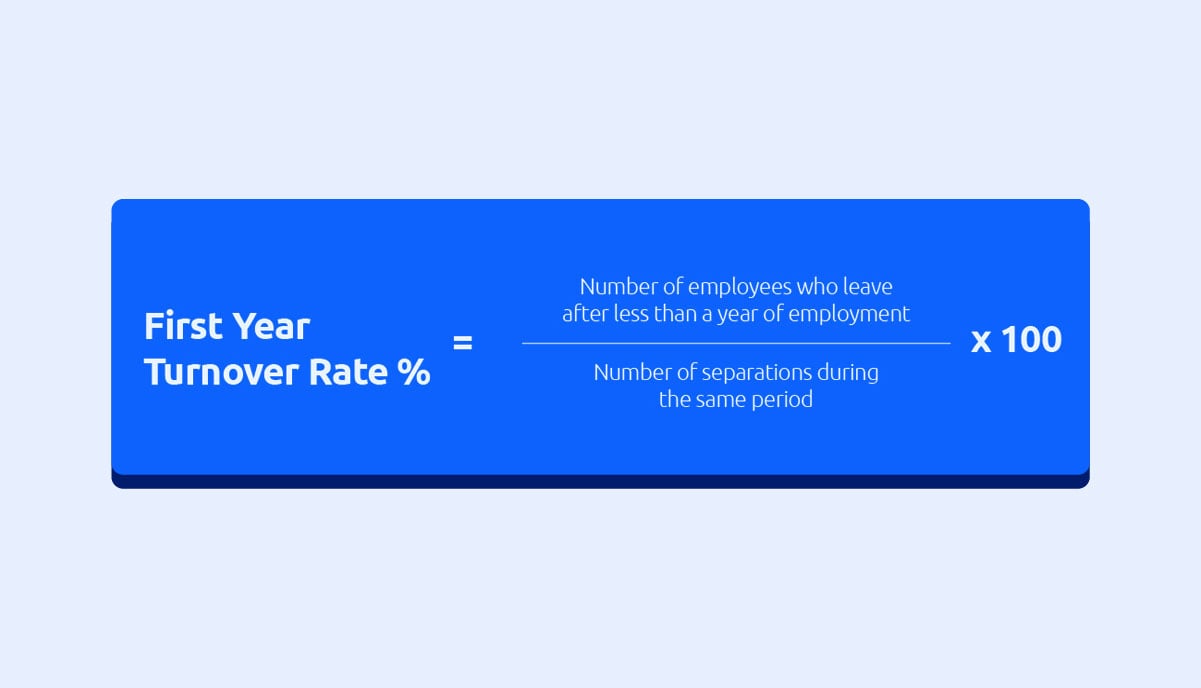
Alternative Formula to Calculate Turnover
There is another alternative way of calculating employee turnover. The proponent of this approach is the American National Standards Institute (ANSI). It says that the turnover rate is equal to the number of terminations divided by the average # of employees for each of the 12 months in the designated annual period.
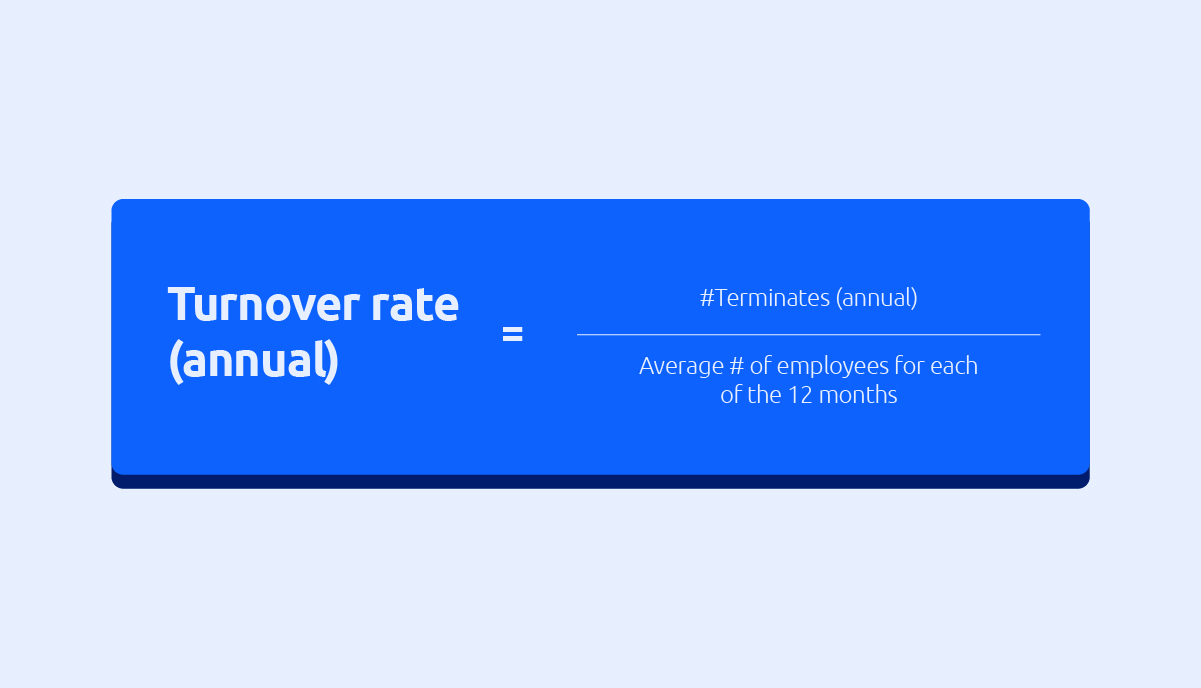
Download Employee Turnover Ratio Calculator Template
Do you need to calculate your company's employee turnover rate quickly? Download our free employee turnover ratio calculator template to simplify the creation of documents. It’s easy to follow and update, while providing consistency when monitoring an organization’s turnover rate.
Develop and Sustain Employee Engagement to Reduce Turnover
Employee engagement remains a critical driver of business success in today's competitive market. Building a culture of high engagement fosters customer loyalty, improves organizational productivity, and promotes employee retention.

If you want to increase employee engagement in your organization, book a demo of Glue Up's Corporate Meetings and Events Suite. With its excellent tools like public & private groups, social media sharing and mentioning, plus a mobile app, you can start workplace group discussions and exchange ideas anytime, anywhere–a surefire way to improve team collaboration and reduce turnover.



